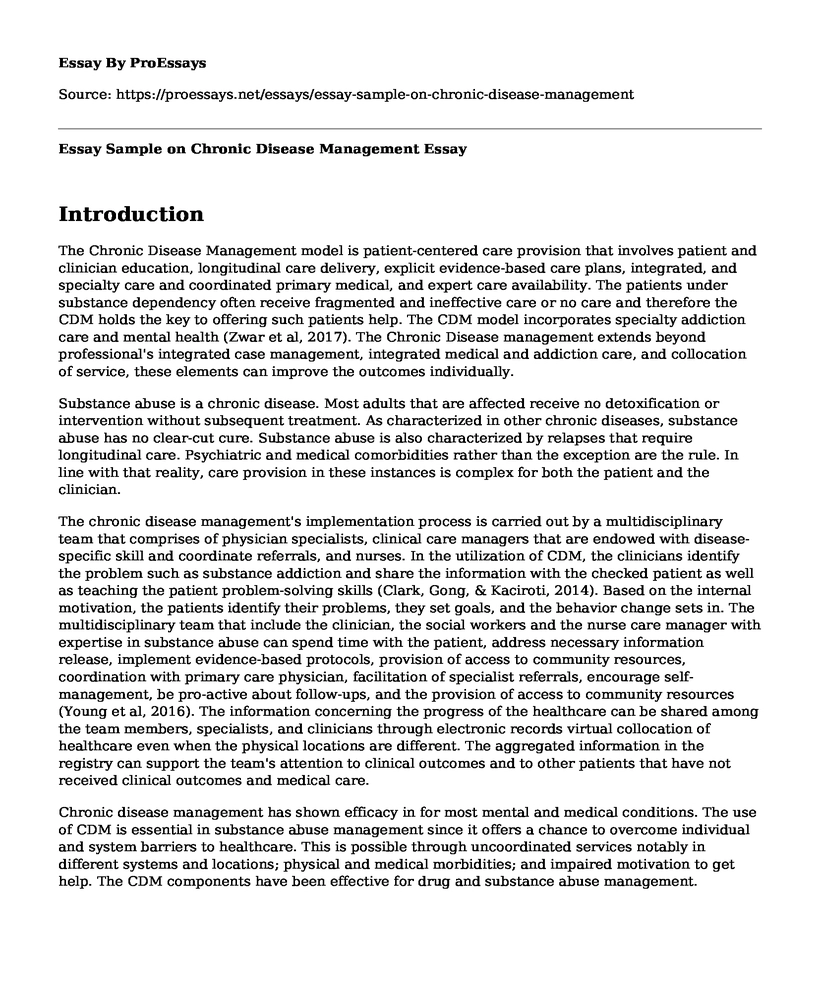Introduction
The Chronic Disease Management model is patient-centered care provision that involves patient and clinician education, longitudinal care delivery, explicit evidence-based care plans, integrated, and specialty care and coordinated primary medical, and expert care availability. The patients under substance dependency often receive fragmented and ineffective care or no care and therefore the CDM holds the key to offering such patients help. The CDM model incorporates specialty addiction care and mental health (Zwar et al, 2017). The Chronic Disease management extends beyond professional's integrated case management, integrated medical and addiction care, and collocation of service, these elements can improve the outcomes individually.
Substance abuse is a chronic disease. Most adults that are affected receive no detoxification or intervention without subsequent treatment. As characterized in other chronic diseases, substance abuse has no clear-cut cure. Substance abuse is also characterized by relapses that require longitudinal care. Psychiatric and medical comorbidities rather than the exception are the rule. In line with that reality, care provision in these instances is complex for both the patient and the clinician.
The chronic disease management's implementation process is carried out by a multidisciplinary team that comprises of physician specialists, clinical care managers that are endowed with disease-specific skill and coordinate referrals, and nurses. In the utilization of CDM, the clinicians identify the problem such as substance addiction and share the information with the checked patient as well as teaching the patient problem-solving skills (Clark, Gong, & Kaciroti, 2014). Based on the internal motivation, the patients identify their problems, they set goals, and the behavior change sets in. The multidisciplinary team that include the clinician, the social workers and the nurse care manager with expertise in substance abuse can spend time with the patient, address necessary information release, implement evidence-based protocols, provision of access to community resources, coordination with primary care physician, facilitation of specialist referrals, encourage self-management, be pro-active about follow-ups, and the provision of access to community resources (Young et al, 2016). The information concerning the progress of the healthcare can be shared among the team members, specialists, and clinicians through electronic records virtual collocation of healthcare even when the physical locations are different. The aggregated information in the registry can support the team's attention to clinical outcomes and to other patients that have not received clinical outcomes and medical care.
Chronic disease management has shown efficacy in for most mental and medical conditions. The use of CDM is essential in substance abuse management since it offers a chance to overcome individual and system barriers to healthcare. This is possible through uncoordinated services notably in different systems and locations; physical and medical morbidities; and impaired motivation to get help. The CDM components have been effective for drug and substance abuse management.
Conclusion
The natural history of the disease that has been caused by substance abuse and the possible mismatch with the treatment models employed as well as the expectations reduce the chances of fully helping the patient (Young et al, 2016). The type of the substance, as well as the duration of use after the first use and the age of the user, will determine the treatment period. Some substances that the patient used are used in conjunction with others while others are consumed individually. The individually consumed substances are easily controlled since the composition of their substances is easily traced and controlled. The CDM is a continuous process that needs reinforcement at every stage.
References
Clark, N. M., Gong, M., & Kaciroti, N. (2014). A model of self-regulation for control of chronic disease. Health Education & Behavior, 41(5), 499-508.
Young, J., Eley, D., Patterson, E., & Turner, C. (2016). A nurse-led model of chronic disease management in general practice: Patients' perspectives. Australian family physician, 45(12), 912.
Zwar, N., Harris, M., Griffiths, R., Roland, M., Dennis, S., Powell Davies, G., & Hasan, I. (2017). A systematic review of chronic disease management. Australian Healthcare Research Institute. Retrieved on 12th March 2018 from https://openresearch-repository.anu.edu.au/bitstream/1885/119226/3/final_25_zwar_pdf_85791.pdf
Cite this page
Essay Sample on Chronic Disease Management. (2022, Apr 04). Retrieved from https://proessays.net/essays/essay-sample-on-chronic-disease-management
If you are the original author of this essay and no longer wish to have it published on the ProEssays website, please click below to request its removal:
- South East Medical Center Case Study
- Conceptualization of Nursing Practice Paper
- Emergency Management: WMD Case Study
- Essay Example on Infants of Depressed Moms: Effects of Maternal Depression and Antidepressants
- Paper Example on 30-Day Challenge: Get 6 Hours of Sleep & Improve Lifestyle
- 'Nursing Profession: Professional Ethics and Guiding Theories' - Essay Sample
- Essay Sample on Interprofessional Collaboration: Enhancing Patient Care & Reducing Medical Errors







